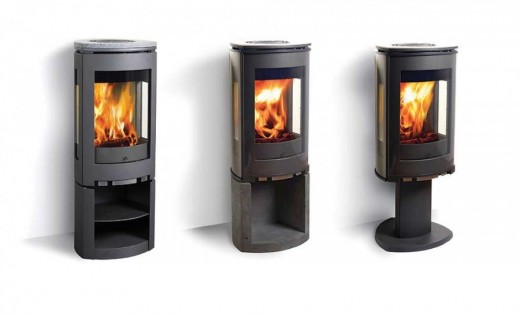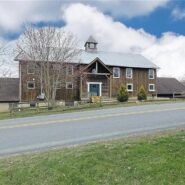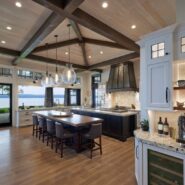Burning Bright: The Evolution of the Modern Woodstove
Sam Pratt | December 30, 2014
[Editor’s Note: This piece originally appeared in the Winter 2014 issue of Upstate House. Read more from Sam Pratt here.]
In the house I grew up in, a menacingly hot woodstove was the unintended focal point of our living room. Our glazed-green Jøtul occupied its own grotto, jutting from the middle of the wall to accommodate an L-shaped flue. The Jøtul needed its very own tile patio to prevent its overheating the hardwood floors.
Though this green monster gave a serious boost to our boiler during the cold months, there was no glass front that would allow us to watch the roaring flames. The chimney belched smoke into the neighborhood, and it required frequent maintenance. While the Jøtul’s looks meshed with a low-ceilinged 19th-century house, tending it required the skills of a locomotive engineer melded with the courage of a lion tamer.
Well, no more. With recent technological advances, most woodstove downsides have been eliminated: fewer emissions, less space, sleeker details. If you were concerned about a Franklin stove clashing with your Harvey Probber and Milo Baughman furnishings, fret not. The occupants of more contemporary, minimal Dwell-ings now have ways to stay warm that blend into a modern interior. Instead of a gigantic, ornate iron box on legs with a clunky old pipe sticking out, one can bring a Danish modern flair to the task of incinerating timber.
For her own home, interior designer Megan Oldenburger of Woodstock-based Dichotomy Interiors opted for a rectangular Large Flush Wood Hybrid-Fyre fireplace insert by FPX: a three-cubic-foot black rectangle that slides into most existing fireplaces, can handle 24-inch logs, and can be watched through a glass face. But, Oldenburger says, “For producing the most heat and being the most efficient, freestanding woodstoves are a better option.” Unlike such inserts, modern woodstoves aren’t prone to ashes blowing back into the room, and involve less constant stoking with fresh fuel.
Oldenburger favors the Shaker model from Wittus for its “clean lines but still a hint of tradition,” with either a long or a short “bench” attached for sitting next to the fire or stacking supplies. This ziggurat-shaped stove sits on spindly yet sturdy legs. And unlike the old Jøtul, you can actually enjoy the fire through a square glass pane—giving the room the best of both woodstove heat and fireplace effects.
For a less mannered and more minimal aesthetic, Oldenburger recommends Wittus’s Cubic line of stoves, which she says evoke “an industrial furnace.” The tallest Cubic unit evokes the enigmatic, dark monolith from 2001: A Space Odyssey, only it’s full of sparks rather than stars.
Mark Mendel of Monterey Masonry in Sheffield, Massachusetts, has retrofitted the homes of what he calls “discerning clients” tired of contending with “obsolete, inefficient woodstoves from back in the day.” As the Wittus dealer for Columbia, Dutchess, Berkshire, and Litchfield Counties, he points out that older stoves are at best 40 percent efficient, “spewing out particulates that coalesce in the chimney and form creosote,” posing health concerns and requiring expensive regular cleanings.
Modern woodstoves, Mendel adds, can achieve as much as 93 percent efficiency, “generating more heat from less wood”—which also means less log lugging. In any case, he says, virtually all woodstoves are more efficient than old fireplaces. Both Mendel and Olderburger agree that fireplaces often draw more warm air up the flue than they project into a room.
Since Wittus units run up to $10,000 for the top-of-the-line models, Mendel recommends Morsø for those seeking similarly clean lines at a lower price point. Built from recycled cast iron, Morsø’s line starts at $999.
The freestanding, cylindrical Morsø 7600 series was designed by Danish art icon Monica Ritterband. Just a little over three feet tall and about a foot-and-a-half wide, the 7600 series can pump out as much as 35,000 BTUs per hour, heating up to 1,200 square feet. The units can be positioned as little as one inch from the nearest wall using a top-mounted vent. For those wanting to clear even more floor space to squeeze in a second George Nelson bench or Eames lounge chair, other Morsø series models can be wall-mounted.
Oldenburger recently previewed some new models featuring a turnable fire area, which allows views from all over the room. She also suggests clients consider the Rais X-Basic model for its sturdy-but-minimal look, which garnered it a Red Dot Design Award several years ago and earned it a place alongside the Nest thermostat and the Nespresso coffeemaker.
Of course, not all modern options will be to everyone’s taste. A few brands trend more toward Jetsons than Philip Johnson. The stoves in Adriano Design’s Stack Stove series sit on thick wooden stools with oblong cylinders or rectangles atop them and a perforated, Connect Four-style top. The Broseley Evolution series edges toward International Style, perhaps conjuring 1990s big-screen TVs.
Read On, Reader...
-

Jane Anderson | April 1, 2024 | Comment A Westtown Barn Home with Stained-Glass Accents: $799.9K
-

Jane Anderson | March 25, 2024 | Comment A c.1920 Three-Bedroom in Newburgh: $305K
-

-

Jane Anderson | January 30, 2024 | Comment A Renovated Three-Story Beauty in Poughkeepsie: $695K
